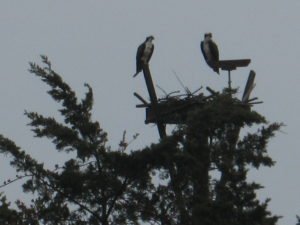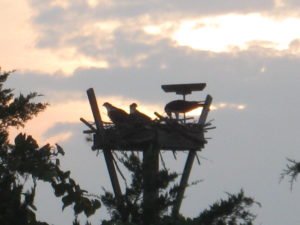By Emma Boskovski On a gloomy Sunday morning, I set out to meet with Dominick Licata. A 71-year-old Smith Point regular, Licata called the Fire Island News to tell the tale of a family of osprey that found their home, constructed by Licata and the community five years ago, heeding the adage “if you build it they will come.”“The project began when my former neighbor, Gordon Best, and his wife, Eileen, came knocking at my door and asked me to help them build an osprey nest,” said Licata. “I helped Gordon dig the hole for the pole that would support the nest. From there, the Suffolk County Department of Parks came and finished the job.”According to the Roy Dennis Wildlife Association, osprey nests can be constructed using a nesting pole if there are no suitable trees. The nesting pole should be about 30 feet in length, and once secure, can be used to place a nest made of sticks, dead grass, moss and leaf litter.Licata, evidently interested in preserving the history and individuality of Smith Point, views the osprey nest as a defining quality of the community. “I knew nothing about the osprey when Gordon knocked on my door,” explains Licata. “I have come to learn lots.”“After the nest was put up, I wanted to promote the ospreys,” said Licata. “I sought a proclamation from Suffolk County to put up signs to try and bring some history back to Smith’s Point.”According to the proclamation obtained by Licata, he had county permission to “place signs to welcome citizens to the Smith Point Hamlet and use those signs to help the businesses on William Floyd Parkway and Neighborhood Road corridors,” back in 2007.“I was absolutely astounded when the current osprey came, and stayed,” said Licata. “Before then, there was five years of ospreys coming and going. Finally, two of the birds came and decided to make the nest home. They now have a baby.”Osprey find homes in New York State in two main locations – Long Island and the Adirondack Mountains. The birds find their homes near coastlines, lakes, and rivers, according to The New York State Department of Environmental Conservation (NYSDEC).
On a gloomy Sunday morning, I set out to meet with Dominick Licata. A 71-year-old Smith Point regular, Licata called the Fire Island News to tell the tale of a family of osprey that found their home, constructed by Licata and the community five years ago, heeding the adage “if you build it they will come.”“The project began when my former neighbor, Gordon Best, and his wife, Eileen, came knocking at my door and asked me to help them build an osprey nest,” said Licata. “I helped Gordon dig the hole for the pole that would support the nest. From there, the Suffolk County Department of Parks came and finished the job.”According to the Roy Dennis Wildlife Association, osprey nests can be constructed using a nesting pole if there are no suitable trees. The nesting pole should be about 30 feet in length, and once secure, can be used to place a nest made of sticks, dead grass, moss and leaf litter.Licata, evidently interested in preserving the history and individuality of Smith Point, views the osprey nest as a defining quality of the community. “I knew nothing about the osprey when Gordon knocked on my door,” explains Licata. “I have come to learn lots.”“After the nest was put up, I wanted to promote the ospreys,” said Licata. “I sought a proclamation from Suffolk County to put up signs to try and bring some history back to Smith’s Point.”According to the proclamation obtained by Licata, he had county permission to “place signs to welcome citizens to the Smith Point Hamlet and use those signs to help the businesses on William Floyd Parkway and Neighborhood Road corridors,” back in 2007.“I was absolutely astounded when the current osprey came, and stayed,” said Licata. “Before then, there was five years of ospreys coming and going. Finally, two of the birds came and decided to make the nest home. They now have a baby.”Osprey find homes in New York State in two main locations – Long Island and the Adirondack Mountains. The birds find their homes near coastlines, lakes, and rivers, according to The New York State Department of Environmental Conservation (NYSDEC). The species almost met extinction in New York State due to excessive amounts of the insecticide DDT poisoning their habitat. From 1940-1969, the osprey breeding population decreased from an estimated 1,000 active nests to an estimated 150 nests.The osprey population has steadily made a comeback on Long Island since the ban of DDT in 1971. As of 1995, there were an estimated 230 breeding pairs of osprey on Long Island alone, according to the NYSDEC. The rebound of the species has been promoted by the building of nests in communities. The tales of manmade nests on Long Island have made headlines since 1991, as seen in The New York Times, a story ran with the headline, “The Osprey’s are Back on L.I., Some in Custom-Built Nests.”“Once again, I knew nothing about osprey before this project,” said Licata. “Gordon and his wife were people I admired. They were the first caretakers of the Flight 800 Memorial, and I knew they had a strong sense of community here in Smith Point. I wanted to embrace that with them.”A protected species in New York State, the location of the osprey nest in Smith Point proves to be safeguarded, as it is surrounded by a fence, poison ivy, and trees to ensure the safety of the birds.“It is amazing to watch the osprey interact with one another,” said Licata. “The family roles of each bird become obvious watching one leave the nest to get food, and another to stay with the baby. I remember the excitement of all of the neighbors the day they came, but more specifically the excitement when they had stayed.”Reporter’s Note: Bird watchers use the term “flushing” to describe when someone gives the location of a particular bird away to the extent that bird watchers, photographers, and possible threats disturb the nesting site. Locations of the osprey nests in this article are spoken in generalities for the sake of the bird’s welfare.
The species almost met extinction in New York State due to excessive amounts of the insecticide DDT poisoning their habitat. From 1940-1969, the osprey breeding population decreased from an estimated 1,000 active nests to an estimated 150 nests.The osprey population has steadily made a comeback on Long Island since the ban of DDT in 1971. As of 1995, there were an estimated 230 breeding pairs of osprey on Long Island alone, according to the NYSDEC. The rebound of the species has been promoted by the building of nests in communities. The tales of manmade nests on Long Island have made headlines since 1991, as seen in The New York Times, a story ran with the headline, “The Osprey’s are Back on L.I., Some in Custom-Built Nests.”“Once again, I knew nothing about osprey before this project,” said Licata. “Gordon and his wife were people I admired. They were the first caretakers of the Flight 800 Memorial, and I knew they had a strong sense of community here in Smith Point. I wanted to embrace that with them.”A protected species in New York State, the location of the osprey nest in Smith Point proves to be safeguarded, as it is surrounded by a fence, poison ivy, and trees to ensure the safety of the birds.“It is amazing to watch the osprey interact with one another,” said Licata. “The family roles of each bird become obvious watching one leave the nest to get food, and another to stay with the baby. I remember the excitement of all of the neighbors the day they came, but more specifically the excitement when they had stayed.”Reporter’s Note: Bird watchers use the term “flushing” to describe when someone gives the location of a particular bird away to the extent that bird watchers, photographers, and possible threats disturb the nesting site. Locations of the osprey nests in this article are spoken in generalities for the sake of the bird’s welfare.































